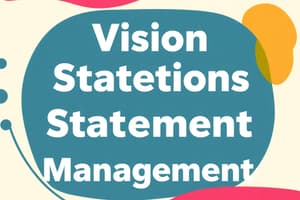Podcast
Questions and Answers
Which characteristic of a mission statement specifically indicates that it should appeal to diverse stakeholders?
Which characteristic of a mission statement specifically indicates that it should appeal to diverse stakeholders?
- It includes detailed strategies.
- It must be specific and measurable.
- It focuses on financial objectives.
- It should be broad in scope. (correct)
What pivotal question does a mission statement answer regarding an organization's focus?
What pivotal question does a mission statement answer regarding an organization's focus?
- What is our business? (correct)
- Who are our competitors?
- What products do we offer?
- How will we grow our profits?
Which statement correctly identifies another name often used for a mission statement?
Which statement correctly identifies another name often used for a mission statement?
- Philosophical statement (correct)
- Product overview
- Vision statement
- Monetary goal
What element is explicitly excluded from a good mission statement?
What element is explicitly excluded from a good mission statement?
In constructing a mission statement, what aspect is crucial for fostering management creativity?
In constructing a mission statement, what aspect is crucial for fostering management creativity?
What primary question does a vision statement aim to answer?
What primary question does a vision statement aim to answer?
Which of the following characteristics is essential for an effective mission statement?
Which of the following characteristics is essential for an effective mission statement?
Which component is typically NOT included in a mission statement?
Which component is typically NOT included in a mission statement?
What is one of the purposes of having clear vision and mission statements in a firm?
What is one of the purposes of having clear vision and mission statements in a firm?
What is a key aspect of formulating a vision statement?
What is a key aspect of formulating a vision statement?
Flashcards
Core Values Statement
Core Values Statement
A statement that outlines a company's commitment to qualities like integrity, fairness, and teamwork.
Vision Statement
Vision Statement
A statement that describes what a company wants to achieve in the future.
Characteristics of a Vision Statement
Characteristics of a Vision Statement
A vision statement should be short, inspiring, and communicate the type of business the firm is in.
Mission Statement
Mission Statement
Signup and view all the flashcards
Effective Mission Statement
Effective Mission Statement
Signup and view all the flashcards
Mission Statement
Mission Statement
Signup and view all the flashcards
Mission Statement Characteristics
Mission Statement Characteristics
Signup and view all the flashcards
Stakeholders
Stakeholders
Signup and view all the flashcards
Vision Statement
Vision Statement
Signup and view all the flashcards
Utility and Products Value
Utility and Products Value
Signup and view all the flashcards
Study Notes
Strategic Management Concepts: A Competitive Advantage Approach, Concepts and Cases
- Strategic Management: A competitive advantage approach, seventeenth edition
- Chapter 2: Business Vision and Mission
- Learning Objectives (1 of 2):
- Explain the need for core values statements in strategic management
- Describe the nature and role of vision statements in strategic management
- Identify the characteristics of a vision statement
- Describe the nature and role of mission statements in strategic management
- Identify and discuss the characteristics of an effective mission statement
- Learning Objectives (2 of 2):
- Identify the components of mission statements
- Discuss the benefits for a firm of having clear vision and mission statements
- Evaluate and write mission statements for different organizations
Figure 2.1: A Comprehensive Strategic Management Model
- Shows a model illustrating the interconnectedness of various strategic topics.
- Includes crucial chapters like Vision and Mission, Strategies in Action, Strategy Analysis, Implementation, Evaluation, and Governance
Core Values Statement
- A core values statement details a company's commitment to attributes like integrity, fairness, discipline, equal opportunity, teamwork, accountability, continuous improvement, and more
Vision Statement
- A vision statement answers the question "What do we want to become?"
- It should be short (ideally one sentence)
- Should reveal the type of business the firm is in
- Inspiring and motivating
What Do We Want to Become?
- Vision statements should be short, ideally one sentence
- Multiple managers should contribute to crafting the vision statement.
- The vision should reflect the firm's type of business
Vision Statement Examples
- Dr. Pepper Snapple: Striving to be the best beverage company globally, known for refreshment, fun, and flavor.
- Starbucks: Aiming to be the world's premier coffee provider, while maintaining their exceptional principles and consistent growth
Mission Statement (1 of 2)
- A declaration of a company's reason for existence
- Answers the crucial question of "What is our business?"
- Essential for goal setting and strategy development
- Should be concise; preferably less than 50 words
- Includes nine components
Mission Statement (2 of 2)
- Reveals the organization's goals and target audience
- A mission statement is also called a creed statement, statement of purpose, philosophy statement, beliefs statement, or statement of business principles
Characteristics of a Mission Statement (1 of 4)
- A good mission statement permits the exploration of various objectives and strategies without hindering management creativity
- The statement should be comprehensive to reflect diverse stakeholder views
Characteristics of a Mission Statement (2 of 4)
- Stakeholders: Employees, managers, stockholders, directors, customers, suppliers, and the public
- (additional note) NGOs and trade Unions (example given in the document)
Characteristics of a Mission Statement (3 of 4)
- Scope: Broad, not focusing on figures or specifics
- Length: Under 150 words
- Inspiring message
- Utility of products: Identifying usefulness of products
- Socially responsible business practices
- Environmentally responsible business practices
Characteristics of a Mission Statement (4 of 4)
- Components: Customers, products/services, markets, technology, survival/growth/profits, philosophy, self-concept, concern for public image, concern for employees.
- Important attributes: Reconciliatory approach and enduring
Insight on Scope of Mission Statement
- Statements are not designed to explicitly detail goals, but rather to inspire motivation, provide direction, portray a vision, and guide the enterprise. Excessive detail can hinder unity and lead to opposition.
Considerations (1 of 2)
- Avoid offering tangible products; instead, emphasize benefits and experiences
Considerations (2 of 2)
- Focus on what a customer gains, not just the product itself. Offer emotions, ambience, and benefits.
Mission Statement Components (1 of 2)
- Detailed breakdown of components crucial for defining a mission statement: customers, service/products, markets (geography), technology, survival/growth/profitability
Mission Statement Components (2 of 2)
- Additional critical elements: Philosophy, distinctive competence, public image, and employees.
Importance of Vision and Mission Statements
- Crucial for establishing a shared understanding of the company's purpose among employees and managers.
- Provides a foundation for strategic planning, which includes prioritizing both internal and external factors to establish feasible strategies for resource allocation, and structuring activities for a common goal
Table 2.5 Ten Benefits of Having a Clear Mission and Vision
- Key benefits include clarity of purpose, strategic planning support, establishing direction, managing stakeholders' expectations, promoting shared ideals, fostering worthwhile projects, achieving higher organizational performance, and achieving synergy.
Developing Vision and Mission Statements
- Procedures for producing vision and mission statements: research, individual input, integration, and revision
Example Mission Statements (1 of 2): Hershey
- Focused on delivering sweet moments
- Shortcomings in alignment with recommended guidelines identified in the text
Example Mission Statements (2 of 2): A Proposed Mission Statement for Hershey
- A more comprehensive mission statement for Hershey, encompassing crucial aspects missing.
Exemplary Proposed Mission Statement (1 of 2) Rite Aid
- Emphasizing a customer-centric approach to experience and overall health improvement.
- Holistic approach toward customers and wellness.
Exemplary Proposed Mission Statement (2 of 2): United Parcel Service (UPS)
- Focus on timely and dependable service aligned with modern technology across various logistical networks.
Figure 2.2 How to Gain and Sustain Competitive Advantages
- Shows a circular model with clear steps involved in achieving and maintaining competitive edge: establish vision/mission, analyze and refine, formulate strategies, implement effectively, and review outcomes
Studying That Suits You
Use AI to generate personalized quizzes and flashcards to suit your learning preferences.




